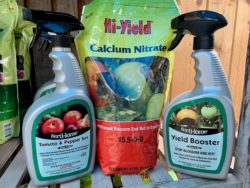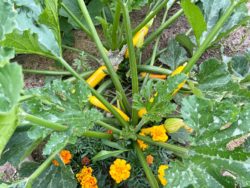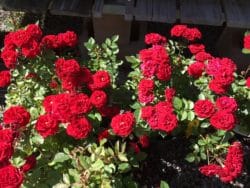How are your tomatoes growing?
Problems with Blossom End Rot? The dark grey, black-sunken area on the blossom end of tomatoes. Though many people think blossom end rot is a disease, it isn’t. Blossom end rot is not caused by a bacteria or fungus, nor is it something that is caused by an insect pest. It is a physiological disorder thought to be caused by stress combined with a lack of calcium in the developing fruit.
During the gardening season, tomatoes develop at a very rapid rate, and they use a lot of calcium in the growing process. When there is not enough calcium present in the plant, the fruit’s tissue breaks down into the sunken lesion you see at the bottom. The blossom end of the fruit is its growing point, so that’s why the deficiency symptoms show up there first.
Keep the soil moisture even to help the plant transport calcium to the fruit. This should include watering twice daily in hot weather especially in a raised bed or container. Apply an organic mulch all around the base of the plant to hold moisture and keep the roots cool.
 Fertilome Yield Booster may help stop and prevent blossom end rot caused by calcium deficiency when applied to foliage after fruit initiation and during sizing period. Or consider adding an application of Hi-Yield Calcium Nitrate to boost the calcium availability to the plant.
Fertilome Yield Booster may help stop and prevent blossom end rot caused by calcium deficiency when applied to foliage after fruit initiation and during sizing period. Or consider adding an application of Hi-Yield Calcium Nitrate to boost the calcium availability to the plant.
Now is the time to apply Fertilome Tomato & Pepper Set to help promote flowering, increase blossom set and increase fruit yield. It is a natural plant hormone that provides Biological Grow Power when applied to flowers and adjacent foliage.
Keep up with your regular fertilizer applications and consider switching to Jacks Blossom Booster formulation.
 Harvest ripe vegetables! This will encourage the plants to continue producing fruit all summer.
Harvest ripe vegetables! This will encourage the plants to continue producing fruit all summer.
Summer blooming shrubs should be pruned for shape after flowering. Remove any dead or diseased branches.
Brown patches in your lawn are probably the result of lack of water in those spots. Your sprinkler head may not be operating properly resulting in poor water distribution which is magnified with the long stretches of hot weather we have been experiencing. Check your sprinkler heads to find out what is going on.
Hot weather tips
When temperatures are over 90 degrees, check flowers twice daily for water, in the morning and again in the evening. Some pots/beds may require additional water applications to fight the heat.
Don’t get caught over-watering when temps cool down again like we are having right now.
Keep up with your regular fertilizer regime.
Flowers that may be struggling in the heat should be moved to a protected location to take off the stress. When it cools down, move them back to original location.
Where a plant has failed, consider filling the hole with a splash of color. Creek Side has a great selection that will work perfectly!
Now is the perfect time to get a second bloom from tired annuals by cutting them back now with a sharp pair of garden shears. Go half-way up the pot and cut all along like bowl cut to remove straggly petunia and callie stems. Then fertilize with Jack’s Blossom Booster, Petunia Feed or All-Purpose. Fresh flowers will arrive in a couple of weeks.
In the perennial bed, deadhead the spent flowers and evaluate general plant health. Cut some unspent flowers for a fresh table arrangement to enjoy in the house or patio!
Perennials can still be planted now particularly on a cloudy day or early or late in the day. Mulch any areas of bare soil to help hold in moisture and keep temperatures cooler.
Apply mulch to the vegetable garden soil. Grass clippings that have not been treated with an herbicide work well when distributed thinly over the soil.
Apply water to lawns early in the day before 9:00am. This will reduce evaporation and allow the foliage to dry off before nightfall to help avoid diseases. Wait to fertilize cool-season grasses like Kentucky bluegrass until later this summer when temperatures begin cooling down.


